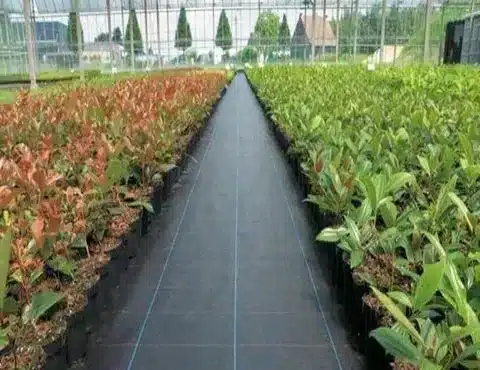+86-159 9860 6917
info@geofantex.com
geofantex@gmail.com
+86-400-8266163-44899
Introduction to Landscape Fabric
Landscape fabric, commonly referred to as weed block or weed barrier, is a versatile material designed to act as a barrier between soil and sunlight. It’s typically made from either woven fibers or non-woven materials and is available in rolls. The primary function of landscape fabric is to prevent soil-bound weed seeds from receiving sunlight, thereby reducing weed growth and minimizing the need for chemical weed control.
Landscape fabric offers several benefits beyond weed suppression:
- Moisture Retention: By blocking the sun, landscape fabric helps the soil retain moisture by reducing evaporation, which is particularly beneficial in areas with dry climates or during hot summer months.
- Erosion Control: In regions prone to heavy rain, landscape fabric provides a measure of erosion control by stabilizing the soil and reducing washouts.
- Support for Hardscaping: It serves as an effective barrier beneath hardscaping elements like gravel or rocks, preventing them from sinking into the soil over time.

Potential Drawbacks of Landscape Fabric
Despite its benefits, landscape fabric has some disadvantages:
- Incomplete Weed Control: While it prevents weed seeds in the soil from germinating, it doesn’t eliminate weeds entirely. Wind can blow seeds onto the mulch above the fabric, allowing them to sprout there.
- Organic Mulch Decomposition: Over time, organic mulches such as wood chips will decompose, creating a layer of compost on top of the fabric that is perfect for weeds to take root. Applying a pre-emergent herbicide can help prevent this issue.
For those who find these drawbacks unacceptable, alternative materials like cardboard, burlap, or newspapers can be used.
When to Use Landscape Fabric
Landscape fabric is best utilized in mulched areas around trees, bushes, and shrubs. It’s typically laid over the soil, with mulch placed on top. This fabric is particularly effective under gravel, rocks, hardscaping, flower beds, and ground covers, where it reduces weeds without the need for chemical control. However, it’s important to avoid using landscape fabric under vegetable gardens or flower beds with annuals, as frequent replanting would be cumbersome.
Types of Landscape Fabrics
- Woven Landscape Fabric: Woven landscape fabric is the most widely used type, made from polypropylene or linen fibers woven together to create a durable, semi-permeable material. This fabric allows water and nutrients to seep through to the soil while preventing weed growth. It’s ideal for weed control around trees, shrubs, and flower beds that don’t require frequent replanting. Woven fabrics typically come in black, green, brown, or natural burlap colors and are often UV-stabilized to withstand sun exposure.
- Spunbond Fabric: Spunbond fabric is a non-woven material made from layers of bonded polyester fibers, making it extremely durable and resistant to tearing. The thickness of spun-bond fabric varies, offering versatility for different applications. Thinner versions are permeable to water and air, making them suitable for use as weed barriers in beds and under rocks. Additionally, they can act as a protective border to deter pests, insects, and invasive grasses. Thicker versions of this fabric are impermeable and are often used in irrigation, drainage, and retaining wall applications to prevent root intrusion and seepage.
- Non-Woven Fabric (Felt Landscape Fabric): Non-woven felt landscape fabric is valued for its strength and water permeability. Available in various thicknesses, it’s a great choice for areas requiring moderate-duty weed control and drainage. The felt-like material is ideal for use in applications where both durability and water flow are important.
Landscape fabric is a highly effective solution for controlling weeds, retaining soil moisture, and preventing erosion. By selecting the right type of fabric for your specific needs, you can enjoy a low-maintenance, healthy garden. Whether you’re using it for strawberry plants or other landscaping projects, landscape fabric offers a practical way to enhance your garden’s performance while reducing the need for chemical interventions.



Get Free Sample
We’ll respond as soon as possible(within 12 hours)





















